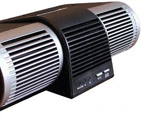The second type of air purifiers employs a chemical modification process instead of mechanical or electronic filters to purify the air. They release a small amount of ozone, which is relatively harmless to humans but is lethal to airborne bacteria and viruses.
Ozone generators
 Ozone, sometimes referred to as activated oxygen, is a very strong oxidizer and has been used in water cleaning since 19th century. Beneficial results can be achieved by introducing a large amount of ozone into areas where people are not exposed. Great concentrations of ozone are used to eliminate microbial growth in meat storage, and to prevent from microbial growth from fire or flood damaged houses. However, ozone has been introduced in ozone generators for cleaning the air where humans are exposed. There is a huge concern of positive and negative effects of ozone in nearby areas. Ozone created by ozone generators circulates in the air and reacts chemically with different airborne particles.
Ozone, sometimes referred to as activated oxygen, is a very strong oxidizer and has been used in water cleaning since 19th century. Beneficial results can be achieved by introducing a large amount of ozone into areas where people are not exposed. Great concentrations of ozone are used to eliminate microbial growth in meat storage, and to prevent from microbial growth from fire or flood damaged houses. However, ozone has been introduced in ozone generators for cleaning the air where humans are exposed. There is a huge concern of positive and negative effects of ozone in nearby areas. Ozone created by ozone generators circulates in the air and reacts chemically with different airborne particles.
Many manufacturers claim that harmless end-products, such as oxygen, carbon dioxide and water molecules, are formed during the chemical reaction. Unfortunately, there are no guarantees that certain chemical reactions could not produce toxic substances. One should not forget that ozone itself can be harmful and toxic if improperly used. The U.S. federal government has set safety requirements for exposure to ozone. On the other hand, manufacturers produce ozone generators that emit ozone at safe levels. The Food and Drug Administration (FDA) requires ozone release of indoor medical devices to be no more than 0.05 ppm. Therefore ozone sensors attached to every ozone generator should be used in order to control the concentration of ozone in a certain area. However, due to excessive cost most manufacturers provide with ozone generators that do not have ozone sensors attached. This generally means that such an ozone generator cannot control the output of ozone at safe limits.
Ozone generators effiency
Hence manufacturers recommend a certain model of an air purifier to be used in a certain size of a room so that the concentration of ozone would not break safety limits. If the consumer uses such a model in a smaller area than recommended by a manufacturer, there is a big danger to people that are in the room. Although most of companies claim that the efficiency of ozone generators is high, experiments show that not all the airborne allergens can be cleared from the air effectively. Chemical reaction process with ozone, to eliminate certain pollutants, takes months or years. Experiments show that not all the chemicals can be removed during chemical reaction process with ozone. Ozone generators are also of small use in clearing the air from dust and mold, the most irritating allergens. However, when constructed together with an air ionizer, an ozone generator could be of greater efficiency to eliminate dust, pollen, mold and tobacco smoke from the air.
Some companies also claim that ozone generators are an ideal option for removing room odor, since ozone reacts with most of the volatile gases to neutralize their odor. Finally, there are many side effects of ozone gas. Higher concentrations of ozone gas in the air that people breathe can be extremely harmful to the respiratory system. Scientists claim that certain side effects are throat irritation and cough, decrease in lung function, chest pain, higher susceptibility to respiratory disease and aggravation of asthma. Hence biozone air purifiers are not a good option for people suffering from respiratory tract disorders. In conclusion, due to the possible side effects of ozone, ozone generators should be used with a high precaution. They should not be used by people suffering from certain respiratory disorders. An ozone sensor should be used with every ozone generator despite excessive costs.